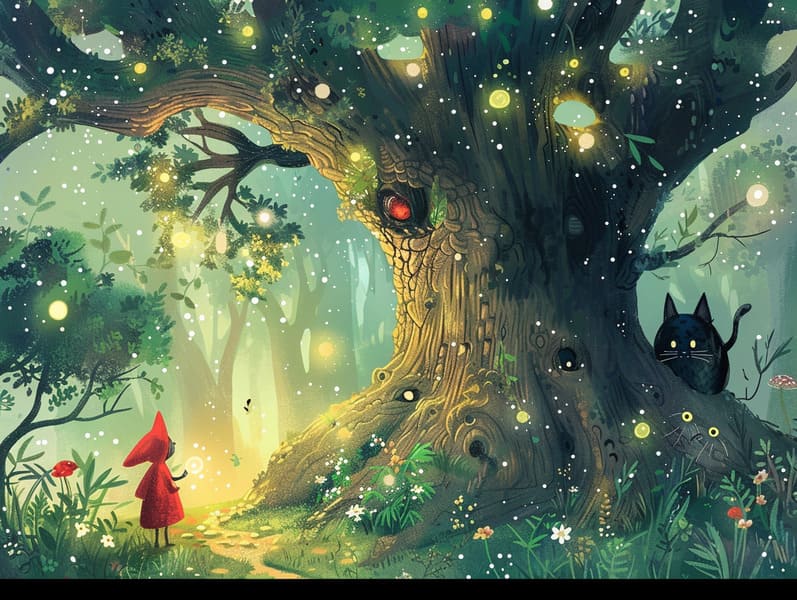The Creation of Bedtime Fairy Tales with Their Immortal Wonder.
The Creation of Bedtime Fairy Tales with Their Immortal Wonder.
Blog Article

Traditional fairy tales have timeless appeal. These narratives have been passed down from one generation to the next far before they were ever transcribed. They arose from a variety of backgrounds, including European traditions. They were initially told among older generations, often carrying themes and messages relevant to the societal norms and beliefs of the time.
Jacob and Wilhelm Grimm, Jacob and Wilhelm Grimm, were among the first to assemble many of these beloved narratives. Their volume, "Grimm's Story Collection," included classics like "Ashenputtel," "The Bread Crumb Trail," and "Snow White," which have since become classics in the world of classic fairy tales. Similarly, Andersen's magical fairy tales, such as "The Story of the Little Mermaid," and "The Duckling that Could," have touched hearts worldwide, establishing their place in the pantheon of timeless fairy tales.
Though they are old, these tales remain as relevant as ever, especially as bedtime stories for kids. These fantastical tales are now available in diverse formats, including vividly illustrated books, magical animations, and free fairy tales online.
Their persistent charm can be connected to several fascinating points:
Key Lessons: Timeless fairy tales often illustrate important moral lessons. Tales like "The Tale of the Boy Who Cried Wolf" teach the importance of integrity, while "The Tortoise and the Hare" show the merits of perseverance and modesty. These narratives offer little ones clear distinctions between ethical and unethical, forming their moral compass in a kind yet meaningful way.
Kindness and Comprehension: Old fairy tales frequently showcase personalities facing trials and tribulations, prompting young listeners to relate with their struggles and champion their triumphs. For instance, "Beauty and the Beast" conveys the value of looking deeper to see the true character of a character, strengthening understanding and knowledge.
Cultural Insights: Many classic fairy tales are deeply embedded in the cultural contexts from which they were born. Exploring these tales can provide informative snapshots into different heritages, advancing a sense of cultural awareness and understanding.
Inventiveness and Imagination: The enchanted elements in timeless fairy tales—magical spells—inspire children’s fantastical thinking. These tales lead readers to enchanted realms, engendering innovative dreams and a sense of mystery that persists a lifetime.
Timeless fairy tales are not only entrancing but also pedagogical. They act as mesmerizing tools in strengthening various cognitive and affective skills in kids. When fairy tales are voiced, they develop verbal development by introducing new language items and sophisticated sentence structures. This practice also enhances auditory skills and attention span, as children listen intently, ready to see what happens next.
Furthermore, examining the themes and characters of old fairy tales can promote reasoning skills and thought processes. Children are taught to find patterns, forecast, and know cause and effect. These talks also further young readers convey their thoughts and feelings, boosting their emotional intelligence.
In today’s technological era, the presence of online storybooks has made these narratives more accessible than ever. Internet resources and digital apps extend ample collections of classic fairy tales that can be perused or played anytime, anywhere. Fairy tales narrated are particularly favored, presenting an captivating way for the young to relish these enchanting tales. Audio stories and read-out-loud videos transport characters and settings to life, often joined by charming sound effects and musical scores that intensify the story adventure.
The unending appeal of timeless fairy tales lies in their ability to change to the present while holding onto their main lessons. Contemporary takes of these fairy tales often highlight more multicultural characters and modern settings, making them familiar to today’s audience. However, the essential messages of bravery, empathy, and righteousness remain unchanged, continuing to move young listeners of all ages.
Traditional fairy tales also offer a sense of assurance and familiarity. They allow a organized narrative with a recognizable beginning, middle, and end, often concluding with the solving of conflicts and the triumph of justice over injustice. This dependability can be reassuring for young readers, sharing a sense of solidity in an fluid world.
Ancient fairy tales continue to bewitch and guide new generations, maintaining their loveliness and significance in modern society. As bedtime stories for kids, they grant a perfect blend of charm and understanding, sustaining moral values, empathy, and creativity. The abundance of online fairy tales and the widespread nature of fairy tales read aloud affirm that these ancient narratives remain within reach to new generations.
By defending and telling these fairy tales, we continue to pay tribute to the rich tapestry of fables and click here cultural heritage. Whether you are accessing a vividly illustrated book, discovering a cyber library, or listening through an read-aloud story, the charm of bedtime fairy tales is always within reach. These stories teach us of the continued force of tales and its ability to hold us together across generations and cultures.
Regardless if you are exploring a vividly illustrated book, enjoying a virtual library, or playing an voice book, the wonder of bedtime fairy tales is always within reach.
These narratives highlight of the unending impact of narratives and its ability to bind us across eras and regions, establishing a link that enchants and educates alike.